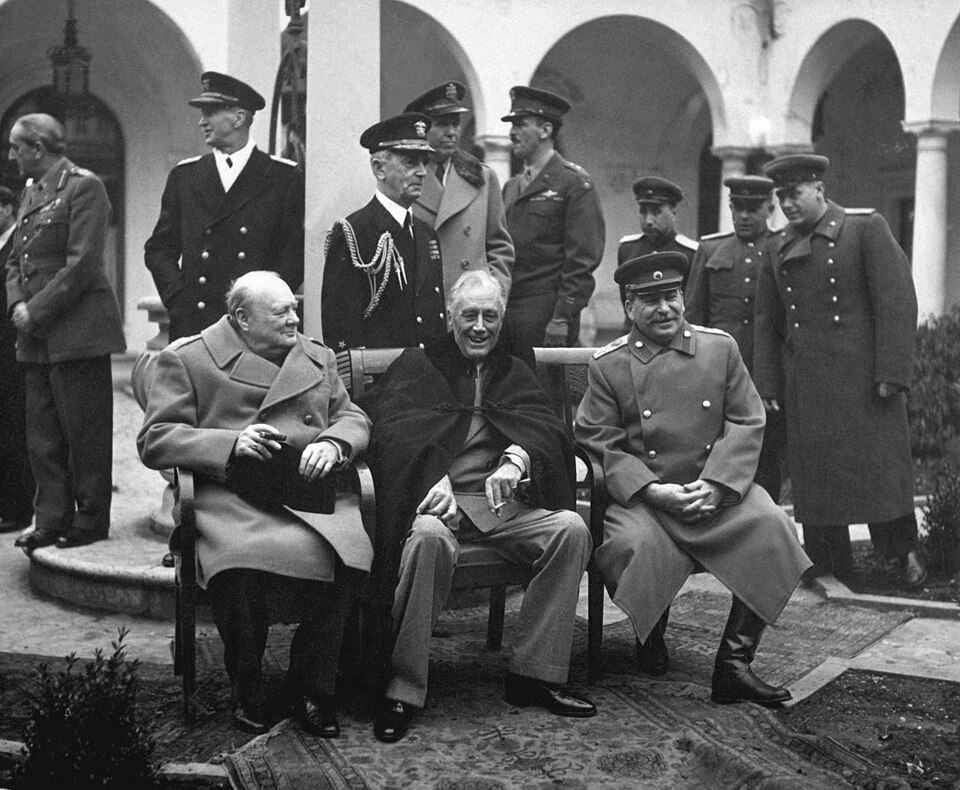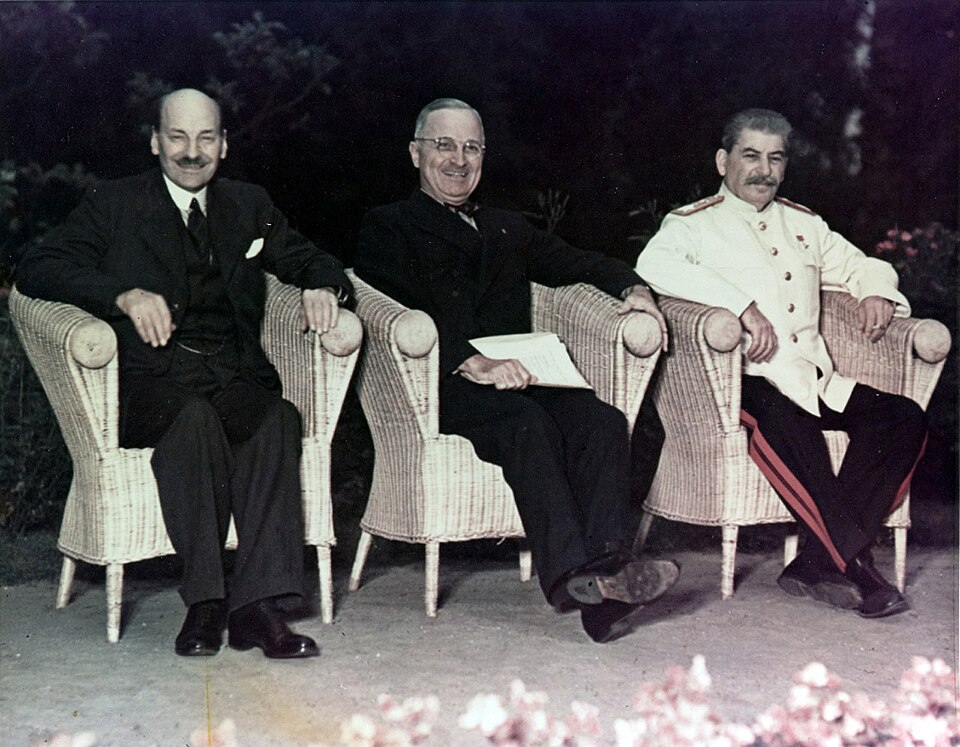OCR Specification focus:
‘relations between Stalin, Churchill and Roosevelt (and later Truman and Attlee)’
The relationships between Stalin, Churchill, Roosevelt, Truman and Attlee defined wartime cooperation, revealed deep ideological divisions, and ultimately shaped the emerging Cold War order.
Stalin, Churchill and Roosevelt: Early Interactions
Wartime Unity and Pragmatism
The Grand Alliance, formed in 1941, was a coalition of necessity between the USSR, the USA and Britain. Despite vast ideological differences, the three powers united against the shared threat of Nazi Germany.
Joseph Stalin demanded recognition of Soviet security needs, particularly territorial buffers.
Winston Churchill sought to preserve Britain’s global influence and limit Soviet expansion.
Franklin D. Roosevelt prioritised maintaining unity and envisioned a post-war international system centred on collective security through the United Nations.
This cooperation was marked by tension, suspicion, and contrasting goals, but necessity outweighed mistrust during most of the war.
Contrasting Personalities and Ideologies
Stalin, the Soviet leader, prioritised survival and expansion of Communism, though he presented his aims as security measures.
Churchill, the staunch anti-Communist, nonetheless made compromises when military necessity demanded.
Roosevelt acted as a mediator, balancing Churchill’s suspicion with Stalin’s demands.
Grand Alliance: The wartime coalition of the USA, USSR and Britain, created to defeat Nazi Germany despite ideological opposition between Capitalism and Communism.
These dynamics explain why wartime collaboration often disguised deep fractures.
Tensions Beneath the Alliance
Stalin’s Demands and Western Hesitancy
Stalin persistently called for a Second Front in Western Europe to relieve Soviet forces on the Eastern Front. Churchill delayed such action, prioritising the Mediterranean strategy, while Roosevelt supported eventual invasion. This delay fuelled Stalin’s belief that the West sought to weaken the USSR deliberately.
Competing Visions for Post-War Europe
Stalin aimed to establish a sphere of influence in Eastern Europe, creating buffer states loyal to Moscow.
Churchill favoured a restoration of traditional European balance, wary of Soviet dominance.
Roosevelt hoped for self-determination but often compromised to secure Stalin’s cooperation.
Roosevelt’s Death and Truman’s Arrival
A Sudden Change in American Leadership
In April 1945, Roosevelt died, and Harry S. Truman assumed the presidency. Truman adopted a firmer stance toward Stalin, departing from Roosevelt’s conciliatory tone.
Truman distrusted Communism deeply.
He was more inclined to back Churchill’s scepticism of Soviet motives.
At Potsdam, Truman demonstrated growing hostility, especially after learning of the successful atomic bomb test.
Sphere of Influence: An area where one power exerts predominant political, economic or military control, often without formal annexation.
This shift intensified suspicions, signalling the breakdown of wartime cooperation.
Churchill and Stalin: Shifting Relations
Alliance of Convenience
Churchill’s relationship with Stalin was pragmatic. Despite anti-Communist convictions, Churchill engaged directly with Stalin in the so-called “Percentages Agreement” (1944), which attempted to divide Eastern Europe into spheres of influence. While never officially ratified, it reflected Churchill’s willingness to compromise strategically.
Breakdown of Trust
Churchill grew increasingly alarmed by Stalin’s actions in Eastern Europe, especially the imposition of Communist regimes. His “Iron Curtain” rhetoric (delivered later in 1946) reflected concerns already brewing during the final wartime months.
Attlee’s Premiership and Its Impact
Change in British Leadership
In July 1945, Clement Attlee replaced Churchill as Prime Minister following Labour’s electoral victory. Attlee’s arrival changed the personal dynamics at Potsdam:
Attlee was less forceful in negotiations than Churchill.
His priority was domestic reconstruction, limiting Britain’s ability to assert strong influence against Stalin.
Nonetheless, Britain remained aligned with the USA in resisting Soviet expansion.
The Decline of British Influence
With Attlee in office, Britain’s weakened economic and military position became more apparent, leaving the USA as the primary counterbalance to the USSR. Stalin increasingly dismissed British objections as secondary.
Stalin’s Calculations with Western Leaders
Manipulation and Control
Stalin exploited the divisions between Western leaders. He portrayed Soviet actions as defensive necessities, often using ambiguous promises of free elections to placate Roosevelt and Churchill.
Deteriorating Relations by 1945
By the end of the war:
Stalin viewed Western hesitancy on the Second Front as betrayal.
Churchill feared unchecked Soviet expansion.
Truman abandoned Roosevelt’s cautious diplomacy in favour of confrontation.
Attlee offered limited resistance, reinforcing Stalin’s belief in Anglo-American division.
Key Turning Points in Relations
Tehran Conference (1943)
Roosevelt and Stalin found common ground, marginalising Churchill.
Stalin secured promises for a Second Front in 1944.
Tensions over Poland and Eastern Europe persisted.
Yalta Conference (1945)
Roosevelt, Churchill and Stalin agreed to the United Nations and post-war division of Germany.

At Yalta, the Big Three formalised plans for Germany and endorsed the creation of the United Nations. The photograph foregrounds leader-to-leader relations while advisors stand behind them. Source
Stalin promised free elections in Eastern Europe but pursued Communist dominance.
Potsdam Conference (1945)
With Truman and Attlee replacing Roosevelt and Churchill, discussions grew more strained.

This photograph presents Attlee, Truman and Stalin seated together at Potsdam shortly after Britain’s change of government. It illustrates the altered personal dynamics confronting the final wartime conference. The image is tightly framed on the three leaders, avoiding background advisors to keep the focus on relations. Source
The USA revealed possession of the atomic bomb, exacerbating mistrust.
Disputes over Poland and reparations heightened divisions.
Conclusion of Wartime Relations
Although the Grand Alliance achieved victory, relations between Stalin, Churchill, Roosevelt, Truman and Attlee deteriorated rapidly. Mutual suspicion, conflicting ideologies, and differing priorities ensured that cooperation gave way to confrontation, laying the groundwork for the Cold War.
FAQ
Roosevelt believed personal diplomacy could build trust with Stalin and secure Soviet cooperation in the post-war international order.
He was particularly focused on establishing the United Nations as a framework for global security and thought compromise would make Soviet participation more likely.
Churchill, by contrast, was more sceptical, viewing Soviet ambitions as a direct threat to European balance.
Roosevelt’s declining health limited his energy and sometimes left him dependent on advisors, which gave Stalin opportunities to press for concessions.
Stalin, by contrast, was highly assertive and often dominated discussions.
Churchill’s forceful style was sometimes overshadowed by Roosevelt and Stalin working more closely, particularly at Tehran.
Advisors influenced the flow of information and helped interpret vague agreements.
Soviet advisors reinforced Stalin’s positions and rarely contradicted him.
Roosevelt and Churchill relied more on military staff and diplomats for technical planning.
Interpreters were crucial in ensuring tone and nuance were conveyed accurately, affecting the atmosphere of talks.
Attlee’s government shifted Britain’s priorities toward post-war reconstruction and domestic reform.
This reduced Britain’s ability to project strong leadership in international negotiations, leaving the USA and USSR as the main powers shaping post-war Europe.
His presence symbolised Britain’s relative decline, reinforcing Stalin’s view of a bipolar world.
Truman’s knowledge of the successful test emboldened him to adopt a tougher stance towards Stalin.
Stalin, already informed through Soviet intelligence, outwardly appeared unmoved but privately accelerated efforts to develop a Soviet bomb.
This secretive tension deepened mistrust and set a precedent for nuclear rivalry influencing diplomacy.
Practice Questions
Question 1 (2 marks)
Name two leaders who attended the Yalta Conference in February 1945.
Mark Scheme:
1 mark for correctly identifying each leader, up to a maximum of 2 marks.
Acceptable answers: Stalin, Roosevelt, Churchill.
Do not accept Attlee or Truman (they were at Potsdam, not Yalta).
Question 2 (6 marks)
Explain two ways in which relations between Stalin and Western leaders changed between the Tehran and Potsdam Conferences.
Mark Scheme:
Up to 3 marks for each valid explanation, showing both description and development.
1 mark: Identification of a change.
2 marks: Basic explanation of the change.
3 marks: Developed explanation that links to the broader context of relations.
Possible points:
At Tehran, Roosevelt worked closely with Stalin and marginalised Churchill; by Potsdam, Roosevelt had died and Truman took a harder stance, showing increased mistrust.
At Tehran, the promise of a Second Front eased tensions; by Potsdam, disputes over Poland, reparations, and atomic weapons heightened divisions.
At Tehran, cooperation was prioritised for defeating Germany; by Potsdam, Stalin’s expansion into Eastern Europe and Western resistance (especially Truman’s) made relations confrontational.
Maximum 6 marks available.

